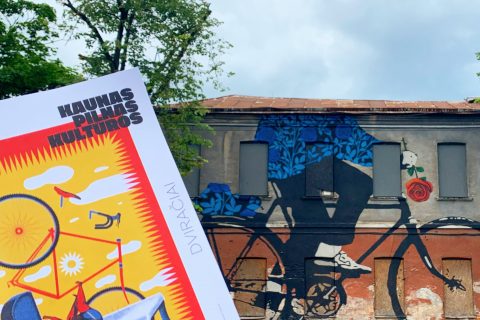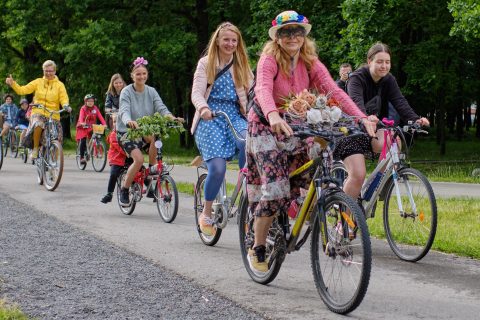In the evenings, when I want to relax, I often sit in Vienybės Square, located between K. Donelaičio and V. Putvinskio streets. The renewed urban space bringing Kaunas residents together on a daily basis and people riding around with the most diverse micro-mobility devices always pleases the eye. More specifically, the representatives of BMX sport. That is what I talked about sitting on the stairs of Vytautas the Great War Museum with Povilas Šaučiūnas, the head of Kaunas Extreme Sports Club, and several riders, often seen riding down the streets of Kaunas.
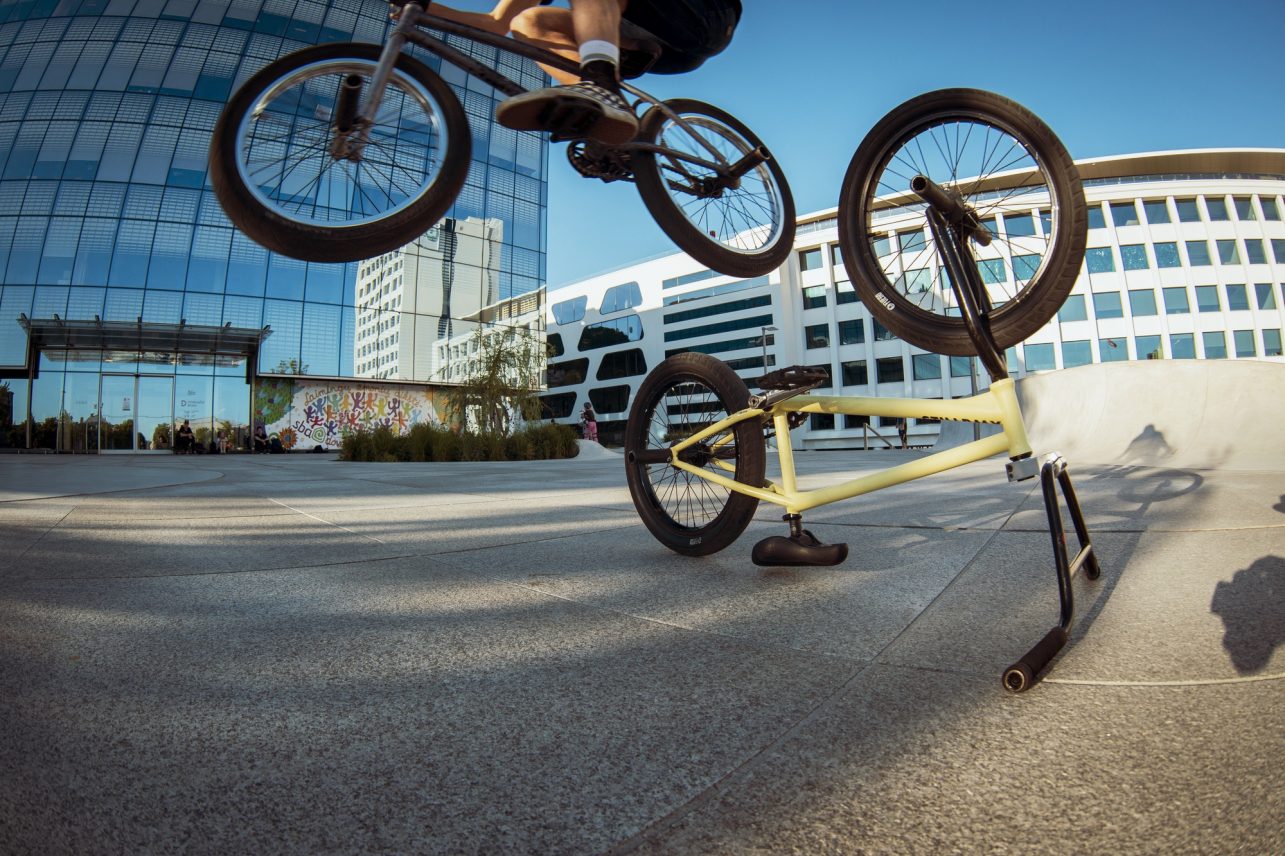
How did extreme sports appear in Kaunas?
Povilas Šaučiūnas: Extreme sports in Kaunas appeared through mobile service providers LABAS. In the past, they actively organized various competitions. If I’m not mistaken, they built the very first skate parks in Lithuania. I remember very well that around 2004 when my extreme sports journey began, they gradually popularized the sport. At that time, the Santaka skate park was built, and the number of riders increased; I had never seen that before.
Svajūnas Širmelis: I think that there was a massive lack of information at the time. We were not familiar with such a sport or extreme sport in general. Eventually, when we saw that the skate parks were sprouting little by little, we started building communities.
Povilas: I agree. There was a turning point, and this sport gained momentum in Lithuania quite quickly. I remember there used to be old Soviet skateboards, but no one skated on ramps, which only started after LABAS initiatives.
Does Kaunas have an active extreme sports community?
Juras Jurgelionis: I would venture to say yes. Many events take place, and we all prepare for them together.
Povilas: Yes, and we, the members of Kaunas Extreme Sports Club, try to organize as many such events as possible – we really want to develop this culture. Vienybės Square is also essential. Many people in Kaunas skate or ride, but there is a lack of places to train. Especially now that both skating and riding BMX are included in the Olympics.
Mantas Armonas: By the way, if I am not mistaken, Vilnius has four parks. This culture has expanded significantly in recent years. I would very much like to see such progress in Kaunas as well.
Povilas, you are currently the head of Kaunas Extreme Sports Club. What prompted the establishment of such an organization in Kaunas?
As I mentioned, over time, the number of people riding and skating started to increase, so it was important to set up an organization that could bring all the enthusiasts together. And that’s what happened: in 2009, this club was founded by the famous Kaunas skater Mantas Ivanauskas. We have been organizing Santaka Reborn competition on our own since 2015, without an official club. After several years, the founder moved away from this sport, so in 2019 I took over the management of the club. I have built a new team and have been working since then. Many things didn’t happen due to quarantine, so we hope to make it up for it.
How did extreme sports come into your lives?
Mantas: I’m from Biržai. When I became interested in this sport, I befriended several like-minded people. I bought a bicycle and started riding, and eventually I started making the first stunts. From the simplest ones to bolder ones. Eventually, I got seriously hooked. Ten years have passed since then. I still ride and enjoy it.
Svajūnas: I remember the day a neighbour showed me a BMX bike. I tried to perform a jump, and I loved it. Over time, I met even more like-minded people, and gradually it became a part of me. Now I ride every single day. I am also thrilled with the community – a bunch of very interesting people and they are like a family. Now, after 12 years of almost daily riding, I understood that this sport has taught me persistence, relentlessness and to pursue my goals. Sometimes it takes months to learn one trick. But you don’t give up and continue learning.
Juras: My beginning was a bit different. As a teenager, I was looking for a sport where I could realize myself. I tried basketball – I got bored because the coach kept telling me what to do. After a while, I thought about this little bike, I tried it once and didn’t let go. Creativity, freedom and the desire to ride opens up here. Now, like the others, I cannot imagine a day without a bike, it has been five years.
Povilas: And I will briefly speak about skateboarding. My journey began at school, maybe in the 5th grade. Someone downloaded a computer game called Tony Hawk, and the whole class started skateboarding. If anyone is interested, the game still exists.
I remember learning one trick all summer, and when I finally did it, I got sad.
How did the learning process look like?
Juras: During the first year, no one helped me. I was the first among my friends to start riding. Of course, there were people who bought a BMX and then quickly gave up. And the learning process probably changed the most when I befriended Kaunas riders. They taught all sorts of tricks, helped to improve together.
Svajūnas: I learned the first tricks together with my friends. We spent a lot of time analyzing the tricks we saw online and then trying to repeat them. We filmed ourselves, we talked a lot. There was a lot of sociality.
Mantas: Svajūnas and I both come from Biržai. He started riding earlier, so he served as a coach for a while. But other than that, like most people, I learned from the internet.
Povilas: It is important to mention that most of those lessons help only in theory. To learn, you have to try it a hundred times, but you must also understand that all those hundreds of times can fail. And then a hundred more.
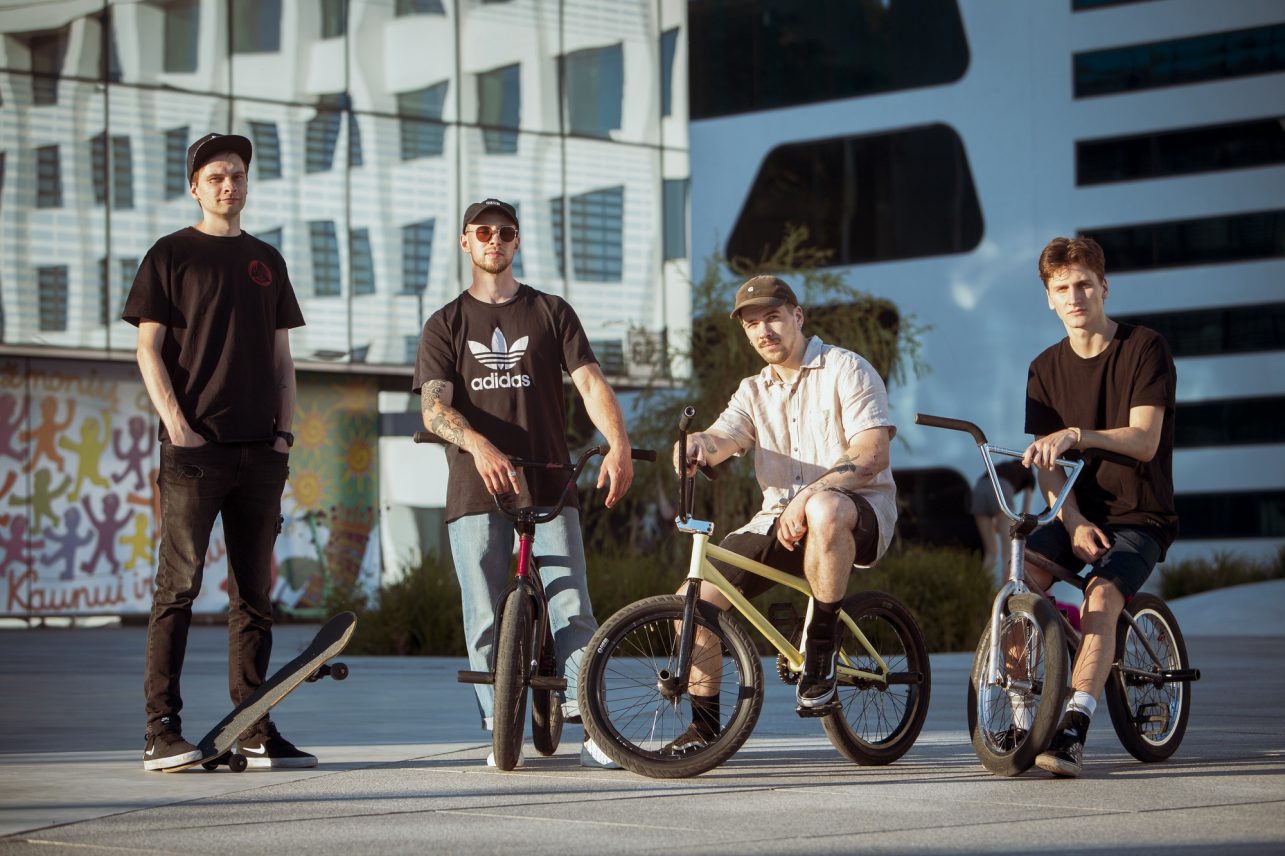
Do you have any fears? Did you have painful experiences?
Juras: I am in the 12th grade, so I was very scared about getting hurt before the exams. I also draw during my free time, so while riding, I try to protect my right hand more.
Svajūnas: I always get scared when trying to do a stunt that involves many stairs. I keep thinking that I will fail or land badly. It seems that subconsciously that I am having a fight with myself: I am scared, but I really want to perform the stunt, so I have to overcome it. Only then I succeed. If you get scared in the middle of the stunt, it is very likely that you will fall, and that can have consequences. I had a broken arm, wrist, sprained ligaments, but the thought of never doing this again haven’t crossed my mind.
Mantas: I suffered a couple of serious injuries a few years ago. It took me a year to recover and get back to this sport. After riding a bit, I experienced one more trauma – my knee ligaments were torn. After half a year, I feel like I am rehabilitated, and I am slowly returning to the sport.
Juras: The scariest thing is not fear but the physical inability to perform a stunt. If you don’t ride, your muscles forget the movements and the chances of injury increase. In your mind, you know what to do, but your hands just don’t listen.
Do you participate in competitions abroad?
Juras: I have visited a skatepark in Riga. It is probably one of the best skateparks in the neighbouring countries.
Svajūnas: I have participated in competitions in Latvia, although, truth be told, I wouldn’t say I like to compete, so it happens rarely. I am also fascinated by the neighbouring countries, their level of sports is higher, everything started earlier there, athletes have more experience.
Mantas: And more funding. New parks emerge more often, providing more room for improvement.
Svajūnas: When you ride with the people who are better than you, you automatically start to motivate yourself, you improve faster. That is why I like to observe competitions; after that, you get home burning with a desire to improve.
Juras: I remember this ramp in the competition in Riga, which we call a sponge. I dared to perform a somersault. When I got back, I really wanted to repeat it, but, unfortunately, we do not have such conditions in Lithuania.
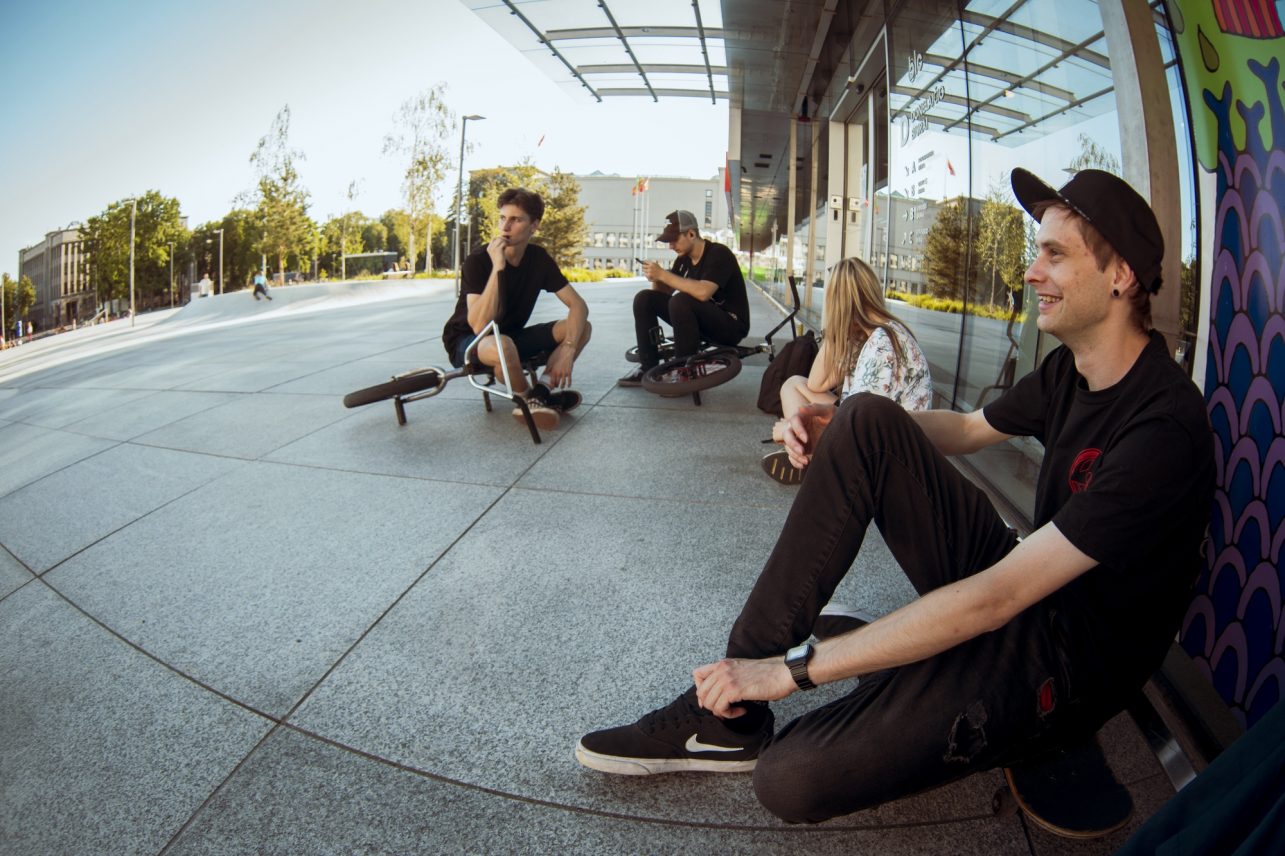
Which country’s extreme sports culture fascinates you the most?
Juras: Latvia. The situation there is better in light-years.
Svajūnas: And Estonia. It hosts one of the biggest international competitions, Simple Session. Our neighbours are really experienced.
Mantas: I would say Barcelona. The urban planning and figures are very extreme sports friendly.
Svajūnas: Interestingly, there are similarities between Kaunas and Barcelona. Latvians always say that when they come to visit. Both in terms of architecture and because of large statues.
How do you progress and improve your skills?
Svajūnas: There are no camps for adults, only for children. We improve by ourselves. We meet often and ride together. I would venture to say that we feel very good together and that helps us grow.
Juras: True, I would not want to ride alone, it would be quite sad.
Svajūnas: It’s a communal sport. It would be harder to perform stunts alone, and I don’t even know why that is. When you ride with friends you’re overcome with good emotions and instantly everything becomes easier.
What is so attractive about extreme sports?
Juras: I remember learning one trick all summer, and when I finally did it, I got sad. The process is very interesting but difficult. You move forward in small steps; however, sometimes, due to trauma, you have to take a few steps back. Of course, there is also the adrenaline aspect. You might feel pain, but you jump, perform a stunt, and don’t feel anything.
Svajūnas: I also like the sense of adrenaline. I like to ride on the streets and perform stunts from extremely tall figures. Sometimes my hands tremble with fear but after I dear, a wonderful feeling overcomes me, like the feeling of victory.
Mantas: It is very good to overcome the fear of the stunt. In the long run, it becomes easier to learn something more complex.
What stunt would you like to perform?
Juras: I would repeat the aforementioned somersault. From the very beginning, I remember looking at how others were doing it, wondering how it was possible, so I felt very strange when I finally succeeded.
Svajūnas: I am happy with every stunt that I perform in a new place or one that I, or anyone else in my environment, haven’t done before.
Mantas: I guess I best remember stunts such as going down the stairs, combining different stunts and the ones that take a lot of time to perform.
Svajūnas, you have a YouTube channel with a series of videos called Sketch. What is the purpose of this channel?
Svajūnas: I have seen that many riders in the US make such videos and since I film, including various MBX stunts, together with some like-minded people, we decided to implement it in Lithuania as well. Initially, we thought that we will have something to remember, but the aspect of popularizing this sport is also very important. In fact, I’ve met kids who said they bought BMX after seeing the videos we created.
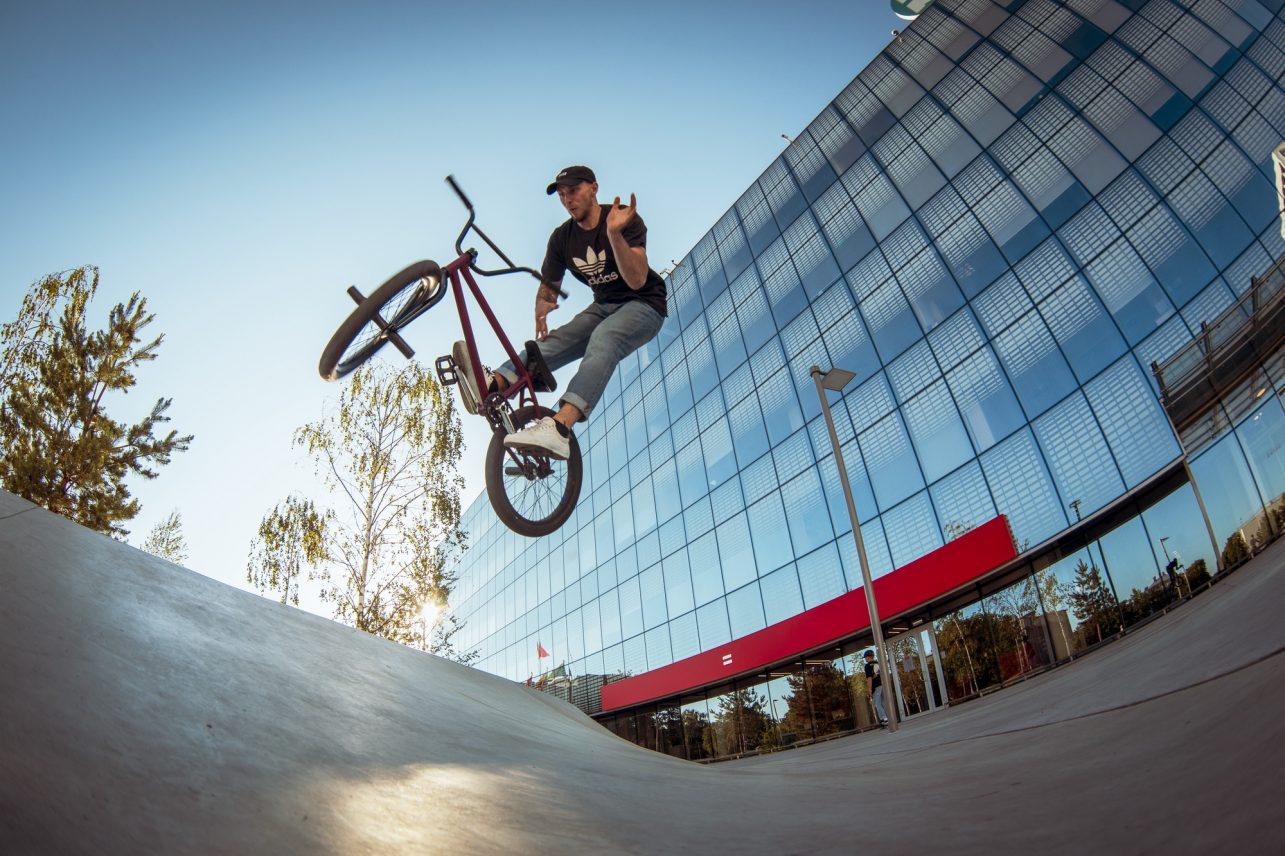
Are there any upcoming events where those interested in extreme sports could participate?
Povilas: Due to quarantine, the events decreased. People were afraid of planning. We are now considering a bigger street competition Kaunas Street Jam in August. We strongly encourage you to follow the news on our social networks.
Svajūnas: In 2012 and 2013, at the end of summer in Kaunas, competitions were held on the street; they were the largest in Lithuania. 100 BMX cyclists rode at the same time. Eventually, the organizers disappeared, and events stopped. Now we all want to revive the legendary Kaunas Street Jam. Let’s meet there!

